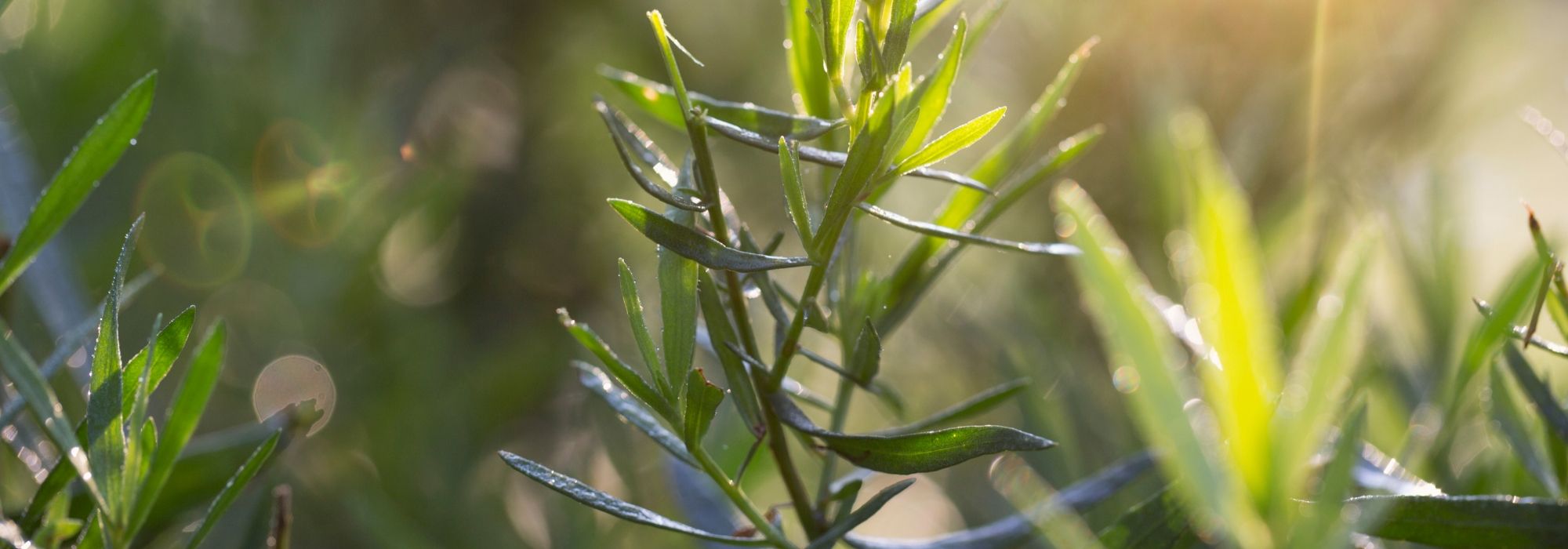
Tarragon: planting, sowing, harvesting
Contents
Tarragon in a nutshell
- Tarragon is an aromatic herb whose foliage gives off a delightful aniseed flavour when crushed
- It is one of the aromatic “fine herbs” prized in cooking
- Its leaves can be used fresh or dried and have many benefits, notably digestive properties
- Tarragon prefers sunny positions and light, well-drained soils
- It is an easy-to-grow plant that can be sown or planted either in pots or in open ground
A word from our expert
Tarragon also called “dragon herb” is one of most fragrant aromatic and culinary herbs! In cooking, its leaves with an aniseed aroma are used fresh or dried to enhance sauces, fish or poultry. But this excellent condiment also offers many benefits and virtues, notably digestive, antioxidant and antispasmodic properties.
If common tarragon (Artemisia dracunculus) is rather tender and benefits from being grown in a pot, there is another tarragon variety: Russian tarragon, which is particularly hardy, taller, a little less aromatic but has the advantage of being sown, common tarragon’s flowers being sterile.
Tarragon, including Russian tarragon, likes sun and rich, light, well-drained soil. They can easily form a clump 80 cm to 1 m tall, so think carefully about location!
Which plants to pair with tarragon, how to do propagation by cuttings of tarragon? Discover our collection of tarragons easy to sow or plant and learn secrets of their cultivation!
Description and botany
Botanical data
- Latin name Artemisia dracunculus
- Family Asteraceae
- Common name tarragon, French tarragon, Russian tarragon, garden artemisia, serpentine
- Flowering July to October
- Height 0.30 to 1.20 m
- Sun exposure Sun
- Soil type All, moist
- Hardiness -5°C to -15°C depending on species
Tarragon, or Artemisia, also called dragon herb, absinthe tarragon, garden artemisia or serpentine, is a herbaceous perennial young plant belonging to family Asteraceae and genus Artemisia, like wormwood and mugwort. Native to Central Asia, it has acclimatised to our gardens but despite Siberian origins, it dislikes harsh winters.
Genus includes more than 300 species among tarragons; two are commonly cultivated: Artemisia dracunculus known as “true” tarragon, “French” or “common” tarragon, which is very aromatic but does not produce seed, and Artemisia dracunculoides (syn. Artemisia Redowski) or Russian tarragon, less fragrant but hardier and which, unlike common tarragon, can be sown.
True tarragon is sometimes confused with Mexican or Spanish tarragon, an aromatic perennial used as a substitute for tarragon but belonging to a different genus (Tagetes) and native to Latin America.
From a twisted stump with a rhizomatous tendency that earned it the nickname “Serpentine”, it quickly forms a tuft with a bushy, erect habit, of average height 0.30 to 0.90 m, but sometimes reaching over 1.30 m for Russian tarragon. It develops a beautiful satin-green deciduous foliage that persists in mild climate.
Leaves are arranged alternately along numerous very ramified cylindrical stems. They are thin, narrow, linear to lanceolate and measure 2 to 6 cm long. Mexican tarragon bears ovate, dentate leaves.
Leaves are smooth, glossy, green to green-grey, glabrous but punctate with glands containing its essential oil on the underside: when crushed, they release a very intense aromatic scent, both spicy, peppery and slightly aniseed, and are used in cooking both fresh and dried. Russian tarragon (Artemisia dracunculus var. inodora) is distinguished by finer, matt, pubescent leaves, and is less fragrant than common tarragon. It gives off such a discreet scent that it is sometimes described as odourless.
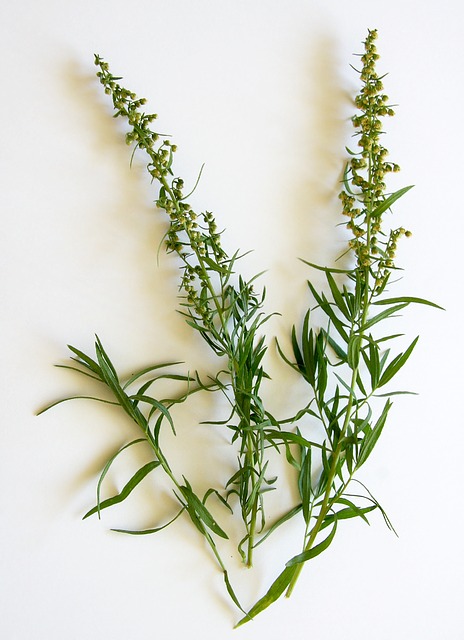
Tarragon (Artemisia dracunculus)
In true tarragon, insignificant flowering appears during summer, from July to October, as tiny yellow-green heads, gathered in the axil of the leaves in light, pendulous spikes. These flowers are sterile and do not allow common tarragon to reseed, unlike Russian tarragon which produces fertile flowers and can be sown. Spanish or Mexican tarragon is marked by flowering in small golden-yellow heads.
Tarragon is very easy to grow in sun, in rich, light and well-drained soil. It is hardy, but only down to -5°C and struggles with severe winters. In regions with harsh winters, grow it in a pot to overwinter sheltered from severe frost. Russian tarragon, or Artemisia Redowski, displays better hardiness (at least down to -15°C) and will regrow from the stump in spring and, in any case, has the ability to reseed itself.
Tarragon will naturally find its place in the garden in an herb garden, with other fine herbs as in a vegetable patch, but also in tubs, pots or window boxes on a sunny terrace or balcony.
This aromatic young plant, rich in vitamin A, has recognised therapeutic properties: its fresh leaves rich in essential oil contain antioxidant, antispasmodic, digestive and sedative virtues.
“Tarragon” means “dragon” or “serpent” in Greek due to the serpentine shape of its roots and its narrow forked leaves evoking tongues of small dragons: for these reasons it was once thought effective as an antidote to snake bites.
Read also
Sowing of aromatic plantsMain species and aromatic varieties
Most cultivated species is true tarragon (Artemisia dracunculus), very aromatic but tender. Russian tarragon (Artemisia dracunculoïdes), is hardier, taller (1.3 m), can be sown, but less fragrant. One is planted, the other is sown!
Most popular
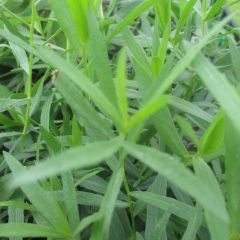
True Tarragon - Artemisia dracunculus
- Height at maturity 80 cm
Our favourites
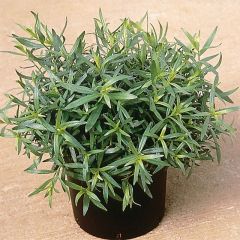
Organic True Tarragon plants - Artemisia dracunculus
- Height at maturity 80 cm
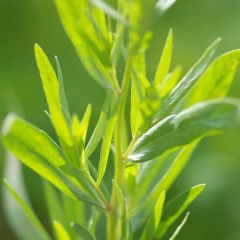
Estragon de Russie Bio - Ferme de Sainte Marthe seeds
- Height at maturity 1,50 m
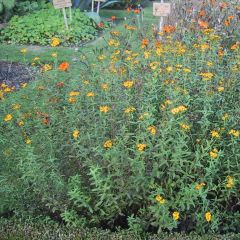
Mexican Mint or Spanish Tarragon - Tagete lucida
- Flowering time July to September
- Height at maturity 50 cm
Discover other Tarragon
View all →Available in 2 sizes
Available in 1 sizes
Available in 1 sizes
Available in 1 sizes
Available in 1 sizes
Available in 1 sizes
Available in 1 sizes
Available in 1 sizes
Planting
Where to plant tarragon?
In the garden, common tarragon is not very hardy, only down to -5°C; it will disappear at first frosts, so in our climates it is grown as an annual or in a pot so it can be sheltered from severe frosts and kept all year round. Russian tarragon offers better hardiness and is able to withstand negative temperatures down to at least -15°C. It can remain in open ground, regrowing from the stump in spring.
They both appreciate rich, light (even sandy), fresh, well-drained soil and a very sunny position sheltered from heavy rain as they like warmth and not much moisture!
In the garden, give them a spot where they can spread freely, as they tend to encroach on neighbours, adopting a somewhat untidy bushy habit.
In small spaces or on a balcony, tarragon is ideal for growing in a pot. It naturally fits in an organic vegetable garden or an herb garden, in the herb bed.
When to plant tarragon?
Our plug plants or young plants of true tarragon are planted in spring, from April to June after severe frosts.
How to plant tarragon?
In open ground
For group planting: space your plants 0.40 to 0.60 m in all directions.
• Loosen soil well
• Dig a hole 2 to 3 times the volume of the rootball
• Spread gravel at the bottom
• Position the rootball
• Backfill with a mix of garden soil and potting compost
In a pot
Tarragon is an aromatic herb that will be as happy in open ground as in a pot on a sunny windowsill or on a balcony in a pocket vegetable garden!
- Spread a layer of gravel or clay pebbles at the bottom of a pierced pot or planter to ensure drainage,
- Plant tarragon in a mix of garden soil and potting compost
- Water regularly
Head to our blog: we share tips on how to plant our plug plants well for a productive vegetable garden!
Discover our advice sheet: how to grow tarragon in a pot?
Read also
Thyme: growing, planting, pruningWhen and how to sow tarragon?
Only Russian tarragon and Mexican tarragon are sown: Russian tarragon and Mexican tarragon are sown: under cover in March–April or outdoors from May to July for harvest from June to October. Most of our seeds carry the AB label and are grown without plant-protection products.
Under cover
- In a seed tray filled with seed compost, sow tarragon seeds 1–2 cm deep, spacing them 5–7 cm apart
- Keep the sowing at around 18°C
- Water regularly but moderately with a fine spray until emergence, which takes about 21 days
- Prick out young plants when they have four leaves, into pots or outdoors once risk of frost has passed
In open ground
Sowing in open ground is done when soil has warmed up after last frosts.
- In well-prepared soil enriched with compost, sow tarragon seeds 1–2 cm deep, spacing them 5–7 cm apart
- Space ranks 20 cm apart
- Cover with a thin layer of compost
- Firm down with back of a rake
- Water with a fine spray and keep soil moist until emergence
- Thin out every 40–60 cm
- Pinch young plants to encourage them to become ramified
- Water young plants regularly to aid establishment
→ Get your sowing of culinary seeds right with our video tips! Alexandra tells you more in How to sow tarragon?
Harvest, storage and use of tarragon
Harvest of leaves of tarragon
Leaves are harvested as needed from July until first frosts. For tarragons kept protected from frost, leaves can be harvested all year round: take entire, non-flowering shoots at the base with a pair of scissors.
Storage
Its aniseed-flavoured leaves are used both fresh and dried. However, freshly picked tarragon is much more aromatic. It keeps for a few days in the bottom of the fridge, or can be dried or frozen. To dry it: leave the leaves to dry in a dry, airy place, chop them then store in an airtight jar.
→ Learn more with our tutorial How to dry tarragon?
Uses
Fresh, chopped, dried, on the sprig or minced, tarragon is one of the most fragrant culinary and condiment herbs. Its uses are numerous! In cooking its aniseed flavour perfumes salads, dressings and sauces such as béarnaise, omelettes, fresh cheese, fish, poultry, vinegar, olive oil or mustard.

Benefits of tarragon
In the past, tarragon was mainly used to treat snake bites or to attenuate dental pain and hiccups. It can be used internally or externally. An essential oil with antispasmodic, digestive and appetising properties is now extracted from its leaves, which are rich in vitamin A, antioxidants and vitamin K. It is effective in cases of aerophagia, for calming muscle spasms, menstrual pain, combating insomnia or soothing hives flare-ups and eczema.
Maintenance, pruning and care
Once planted, tarragon needs almost no care.
It prefers fresh soils: water moderately, but give regular waterings during prolonged drought. In a pot, do not let water stand in saucers.
Pinch young stems to encourage them to ramify. Cut flowers at flowering to favour development of foliage.
Mulch base of clump in spring with grass clippings to maintain sufficient coolness at the base and with dry leaves or ashes in autumn to protect the stump from severe frosts. When spring returns, hardiest tarragons such as Russian tarragon will regrow, others will disappear at first frosts. Uproot clumps or pot them so they can be kept safe from severe frost.
In autumn, for plants left in ground, add compost by raking in to a depth of 5 cm. In March, cut back old foliage of Russian tarragon and remove all dry stems to encourage growth of new leaves.
Possible diseases and pests
Not very prone to disease, Tarragon can sometimes be sensitive to powdery mildew during prolonged drought. To prevent this harmless fungus from leaving a white coating on the foliage: spray with Bordeaux mixture or nettle manure. You can find how to prevent and treat powdery mildew on our blog.
Tarragon has an enemy: rust, recognised by the orange pustules it leaves on the leaves. Avoid its appearance by not wetting the foliage, as humidity favours its development. As a preventive measure, spray with Bordeaux mixture. In case of infection: remove diseased leaves.
Aphids can infest your tarragon without being fatal; they make leaves sticky and can nevertheless reduce its vigour; spray a solution of water mixed with black soap.
Multiplication: division, propagation by cuttings
True tarragon, unlike Russian tarragon and Mexican tarragon is not sown but is divided and propagated easily by cuttings in spring or autumn. We recommend dividing clumps every 3 years to maintain vigour. Russian tarragon and Mexican tarragon are very easy to multiply from seeds harvested in autumn in the garden (find our advice on sowing tarragon in the ‘How to sow tarragon’ section).
By dividing clumps
- Start by lifting the clump with a digging fork,
- Use a spade to lift a shoot with its roots
- Replant immediately in ground or in a pot filled with moist potting compost
Tarragon propagation by cuttings
- In August, take non-flowering shoots about 10 to 15 cm long
- Remove leaves from lower half of stem
- Pot up cuttings in a well-draining mix of river sand and turf
- Keep substrate moist and in humid conditions under a plastic bag until rooting
- Protect plants from frost
- Plant out the following spring
- Pinch out tips of young cuttings to encourage bushier growth
- Water well at planting
→ Also read our tutorial : How to divide tarragon?
Which plants pair well with tarragon?
With its simple, bushy habit, tarragon can be grown everywhere, whatever the size or style of garden: in pots on terraces or balconies and in the ground, in the aromatic herb garden, in a medicinal herb bed, at the edge of a vegetable patch and even within herbaceous borders.

An example of a combination: True tarragon, mint, chives, fennel and parsley
It naturally pairs with other aromatic perennials such as mints, chives, parsley, mountain parsley and fennel, which will enhance your salads, dressings and herbal teas!
Find even more ideas to incorporate aromatic plants into your garden in our guide!
Useful resources
- To go further, also consult our ‘Vegetable garden’ files: ‘aromatic plants’, “Sowing aromatic plants”, or “Sowing culinary herbs”
- Find inspiration in our article on raised vegetable beds
- Here is a selection of 15 medicinal plants with many benefits… to grow in your garden!
- The finest aromatic seeds are in our nursery!
- Discover our advice sheet: Growing tarragon in a pot
- Discover our tutorial: How to divide tarragon?
- Subscribe!
- Contents
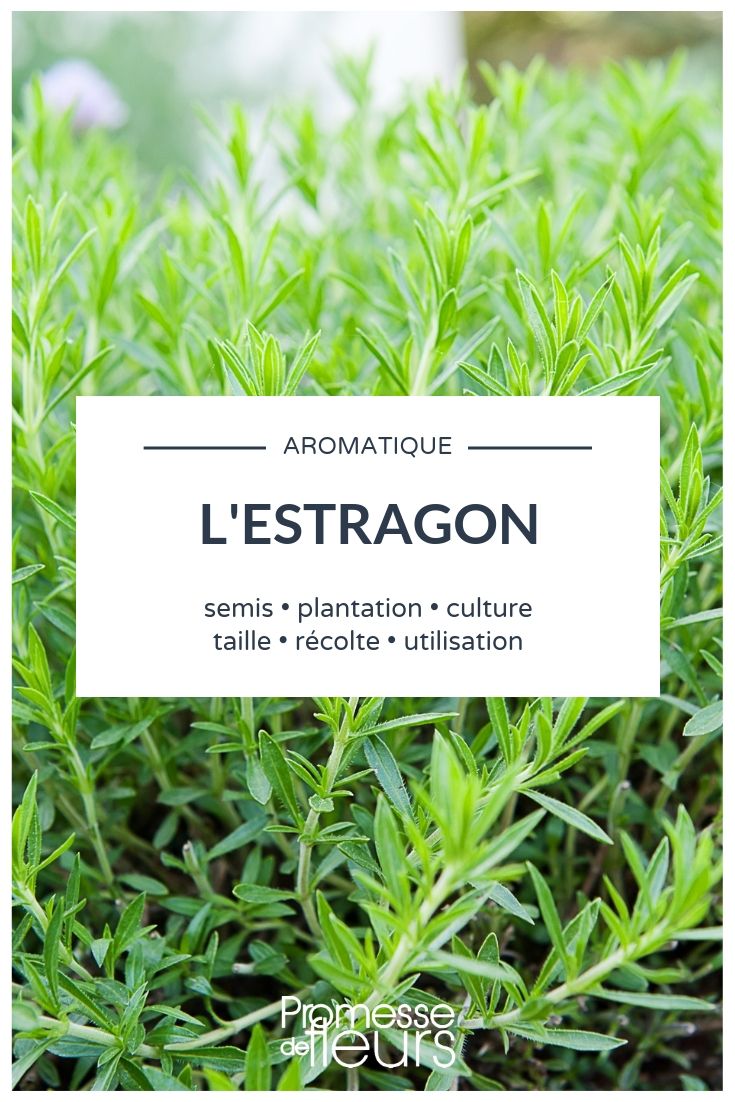































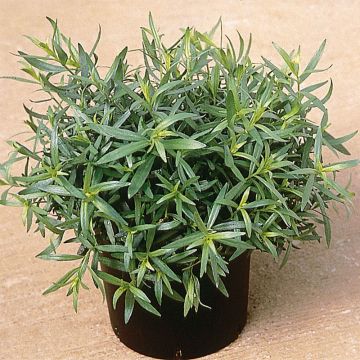

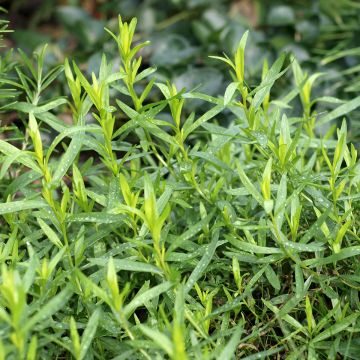

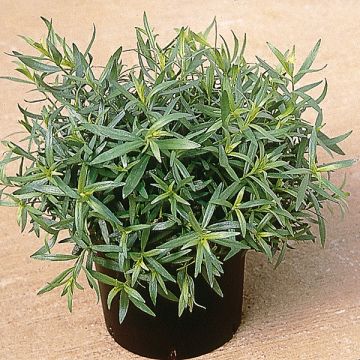

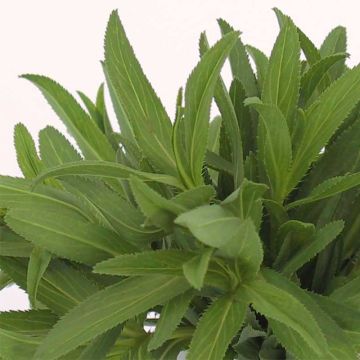

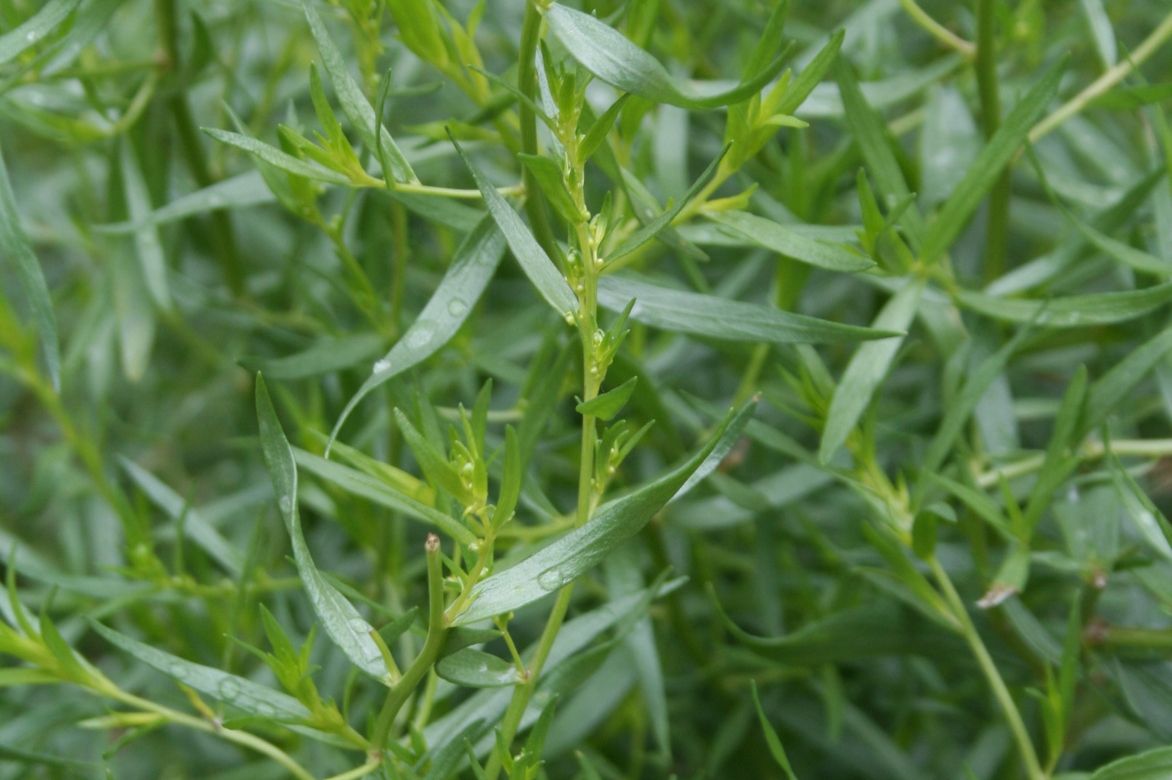
Comments